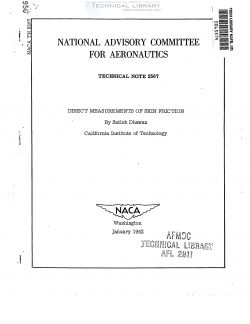naca-tn-2567
- Version
- 128 Downloads
- 2.28 MB File Size
- 1 File Count
- January 9, 2017 Create Date
- January 9, 2017 Last Updated
National Advisory Committee for Aeronautics, Technical Notes - Direct Measurements of Skin Friction

A device has been developed to measure local skin friction on a
flat plate by measuring the force exerted upon a very small movable
part of the surface of,a flat plate. These forces, which range from
about 1 milligram to about 100 milligrams, are measured by means of a
reluctance measuring device. The apparatus was first applied to measure—
ments in the low-speed range, both for laminar and turbulent boundary
layers. The measured skin-friction coefficients show excellent agree-
ment with Blasius’ and Voh Karman‘s results. The device was then applied
to high-speed subsonic flow and the turbulent-skin—friction coefficients
were determined up to a Mach number of about 0.8. A few measurements in
supersonic flow were also made.
The paper describes the design and construction of the device and
the results of the measurements.
An object moving through a fluid experiences a drag force which can
be decomposed into pressure drag and skin friction. This division is
the same whether the body moves with supersonic or subsonic speeds. At
present, wave drag and induced drag are by far better understood both
experimentally and theoretically than skin friction and boundary—layer
separation. This is particularly true for supersonic velocities, but
it is also curiously enough true that experimental investigations of
skin friction in the subsonic range and in incompressible flow are
exceedingly rare.
Recent advances in the design of high—speed aircraft and missiles
have shown that a more exact knowledge of skin friction (and heat trans-
fer, which is related) is of great importance. Theory of the laminar
boundary layer and of laminar skin friction both in low-speed and highs
speed flow has been worked out to a considerable extent in the course
of the last decade. In Spite of the lack of detailed experiments on
laminar skin friction, it is generally felt that the theoretical results
are adequate and trustworthy up to Mach numbers of the order of h.
Beyond this range, for hypersonic velocities, new effects such as dis—
sociation, variable Prandtl number, and so forth appear and the present
theory does not seem to be adequately explored.
| File | Action |
|---|---|
| naca-tn-2567 Direct Measurements of Skin Friction.pdf | Download |
Comment On This Post